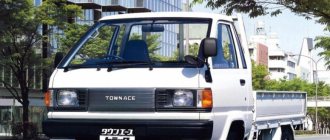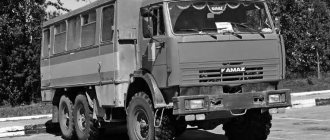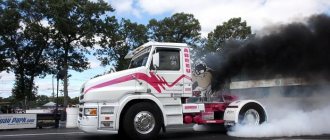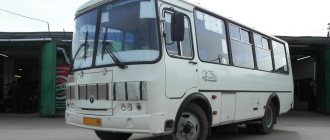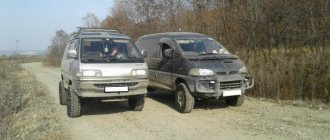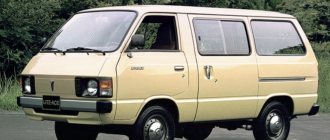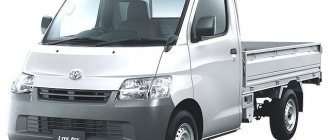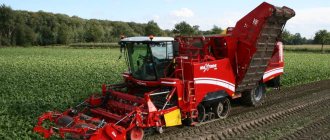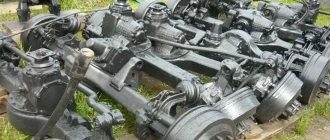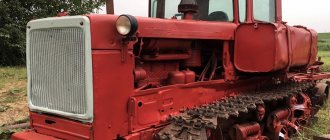Trucks like Toyota Dune have been in consistently high demand in our country over the past decades. The secret of such popularity lies in their carrying capacity, which, depending on the modification, can range from 1-1.5 tons to 2-3.5 tons. It is this category of trucks that is necessary for small businesses, commercial network enterprises, and small-scale construction.
The Toyota Toyoace truck is also known all over the world - a car completely identical to Dune, produced for the domestic market of Japan and in some countries. They differ only in the presence or absence of various modifications. For example, Dune is available only with a single-row cabin, while Toyoace can also be equipped with a double-row cabin with additional seats for passengers.
There are more than enough competitors in the light commercial truck segment. Among Japanese manufacturers, the main competitors are Isuzu Elf, Mitsubishi Fuso Canter and Nissan Atlas.
Let's take a seat
Getting into the cabin is very comfortable: optimally located footrests greatly facilitate the process. But as soon as the driver slams the door, it turns out that he is deprived of living space: while driving, your right elbow constantly rests against the door.
But moving from the driver's seat to the passenger seat and back is convenient. The gearshift lever, which gets in the way on other cars in such situations, folds here, freeing up the passage. There is plenty of space in the rear, even for three. It’s just that you can’t stretch your legs. By the way, the seat cushion rises, which allows you to use the entire rear compartment for carrying cargo.
Looking around
This is not to say that the ergonomics of the driver's seat are well thought out. But when compared with the same Gazelle, the only drawback of Dyna is right-hand drive. Otherwise, everything is normal. The steering column is adjustable in angle, the seats are adjusted in length (and only the backrest is practically “dead”). But, for example, driving in Transit is more comfortable.
The performance of some controls raised serious doubts about the reality of the mileage on the odometer (about 164 thousand kilometers). For example, the gearshift lever had long strokes and low selectivity.
The instrument panel turned out to be quite sparse. As a rule, our trucks have a lot of different instruments and indicators. And in Dyna it’s like in a passenger car: a speedometer and a couple of indicators: engine temperature and fuel reserve.
Specifications
Engine
Modern versions of the Toyota Dyna truck are equipped mainly with a diesel power unit equipped with a turbocharging system. This engine has a displacement of 4 liters and a maximum output power of 150 horsepower.
However, such power indicators are not observed in all models. Some configurations may have a maximum power of 136 horsepower or 180 on the same engine.
There are also separate modifications equipped with gasoline and gas engines, as well as hybrid power plants.
checkpoint
Depending on the configuration, Toyota Dyna trucks can be equipped with either a five-speed or six-speed manual transmission. Both gearboxes have rear-wheel drive, but all-wheel drive modifications are also available on the domestic Japanese market.
It is worth noting that in addition to a manual transmission, cars are also equipped with an automatic transmission, but such equipment is only available as an additional option.
As far as the clutch is concerned, the Toyota Dyna uses a single disc, dry, hydraulically operated friction clutch.
Let's go
A soft, informative clutch pedal makes it easy to get going, and the high-torque, naturally aspirated diesel engine readily accelerates the car in any gear (as on full-fledged trucks, the first gear is only here for starting off loaded on an uphill slope).
There was one thing I didn’t like: on the highway you feel like sixth gear is “missing”, because in fifth at a speed of 80 km/h the traction reserve is simply insane, but the engine is already quite noisy. And it is still “allowed” to accelerate up to 135 km/h.
Cargo carriers sometimes have to work in the most unfavorable conditions. For example, in a very tight space. And here the Dyna's amazing maneuverability comes to the rescue: the car turns almost on the spot.
Another situation that, unfortunately, can confuse the driver is entering an area where snow has not been cleared since the beginning of winter. An empty car on virgin soil fifteen centimeters deep is helpless: driving out under its own power will be somewhat problematic. One joy is that first and reverse gears are located opposite each other, so you can drive out using the swing.
Just don’t be alarmed when you turn on the rear: as expected by Japanese standards, in this case the sound alarm “comes to life.”
Motor 3B
In 1982, the 2B was replaced by the 3B engine. Structurally, this is the same four-cylinder diesel engine with two valves per cylinder, in which the working volume is increased to 3431 cm3. Despite the increased volume and increased maximum speed, power dropped by 2 hp. Then more powerful versions of the engine appeared - 13B, equipped with direct fuel injection, and 13B-T, which has a turbocharger. In more powerful versions, a modernized pump of reduced size and a trochoid, instead of a gear, oil pump were installed.
Motor 3B
Between the oil pump and the filter on the 13B and 13B-T engines, an oil cooler was installed, which was an antifreeze-cooled heat exchanger. The changes led to an increase in the distance between the oil intake and the pump by almost 2 times. This slightly increased the engine's oil starvation time after startup, which did not have the best effect on durability.
Series 3B motors were installed on the following cars:
- Dyna (4th, 5th, 6th generation)
- Toyoace (4th, 5th generation)
- Land Cruiser 40/60/70
- Coaster bus (2nd, 3rd generation)
Engines 13B and 13B-T were installed only on the Land Cruiser SUV.
Compare with “classmates”
Perhaps our only competitor to Toyota Dyna is the Russian Gazelle. It occupies almost the entire market for cars of this type. And this is understandable. With all its inherent shortcomings, the Gazelle remains the most affordable truck with a payload of 1.5 tons. In addition, it can be easily repaired in our conditions.
We have practically no foreign cars in this market segment. Most people buy either minibuses or all-metal vans. And trucks are only of larger tonnage.
Evgeniy KARIMOV. Photo by Anatoly GORNOSTALEV
up
Engine 15B
The range of B series engines is completed by the 15B-F, 15B-FE, 15B-FTE motors, introduced in 1991. 15B-FTE is still produced and installed on the Toyota Megacruiser.
Toyota Mega Cruiser
In this engine, the designers abandoned the lower cylinder design and used a traditional DOHC system with narrow cams. The camshaft is located in the head above the valves. This scheme, using turbocharging and an intercooler, made it possible to achieve acceptable traction characteristics. Maximum power and torque are achieved at lower revs, which is what is required for a military all-terrain vehicle.
And the truck can be beautiful
Why do I need such a specific car at first glance? Necessary. Let's say my job involves transporting something heavy and large. And on weekends, the Toyota Dyna serves as the family car.
Some people think that a truck cannot be beautiful. And for me, there is nothing more beautiful than my “Dune”. The angular two-row cabin and the same angular canvas “scow” on the body create a solid and attractive image.
It would seem that it is impossible to make the flat “face” of a carriage-type cabin beautiful. Toyota Dyna proves otherwise. The huge overlay, highlighted in silver, has a very intricate shape. The radiator grille, four rectangular headlights, direction indicators and a huge embossed “TOYOTA” lettering seem to be carved into the “body” of the cabin.
When my family and I go to the city (for example, to the theater), passersby look with interest. But we don’t care about such looks (why are you looking askance, dear?), the main thing is that it’s convenient for us.
Peculiarities
The Toyota Dyna truck, like many other similar trucks, has a cabover design where the power unit is installed under the cab. This design made it possible to reduce the overall dimensions of the machine and thereby make it more maneuverable. The truck has a fairly spacious cabin and a relatively long cargo platform.
The basis for this model was a classic frame, the manufacture of which uses high-quality steel. It also contains spars, providing truly high strength to the entire structure.
For consumers, the manufacturer offers not only a standard flatbed model, but also a tilt truck, a van and several other various modifications.
Soft plastic and high-quality fabrics were used inside the cabin. Some trim levels feature velor upholstery. The driver's seat is equipped with several adjustment options, allowing the driver to choose the most comfortable position based on his body type. There are two passenger seats on the right. The truck comes standard with power windows. There are modifications that have a double cabin. But it is worth noting that with this equipment the loading platform may be shortened.
Almost a house on wheels
My household perceives the two-row cabin of the Toyota Dyna as a small house on wheels. The interior is decorated with light beige plastic, which is not of the poorest quality. However, this is only for the inhabitants of the front row, and the rear passengers are surrounded by bare metal. It’s okay, you can put wallpaper there...
To my left there is room for two people: there is a small sofa for them. In principle, four people can be seated in the back, but it will be a bit cramped for them. Thus, the total passenger capacity is six people.
The front and rear rows of the cabin are separated by a power crossbar with service functions for rear passengers. They can use an ashtray and hooks for bags. The perfect place for my mother-in-law with her eternal string bags. What, “darling,” is the seat a bit hard and there’s nowhere to stretch your legs? It’s okay, just be patient, we’re taking you to a barbecue, now we’ll get to the place, light a fire, and there you’ll get comfortable.
Last summer, my family and I often went camping overnight. The covered body of the Toyota Dyna temporarily became a living tent, and the spacious cabin became a living room. However, the main purpose of this car is to carry cargo. If the volume of the body is not enough, you can fold the rear row seats, and you will get additional, and not at all small, useful volume.
Reliability and durability of B series motors
There are legends about the indestructibility of these engines. A fairly simple design, a large margin of safety, and the ability to repair “on the knee” made these units indispensable in off-road conditions.
Turbocharged engines are not as reliable. Engine supercharging technology at that time did not reach the same degree of perfection as in our time. Turbine support bearings often overheated and failed. This can be avoided if you let the engine idle for a few minutes before turning it off, which was not always observed by everyone.
Floods are not scary
The fact that the Toyota Dyna is still a truck is evidenced by its behavior on the road. Most of the holes and potholes have to be overcome carefully, and not at all because of the weak suspension. In fact, it is very strong, but, like real trucks, it is not comfortable.
The driving position is comfortable, but you have to sit with an almost vertical back. Nothing can be done - these are the features of the carriage layout. The large power steering wheel is not a masterpiece, but the gear lever has an interesting function. Just pull the wide ring and it folds almost parallel to the floor. This is done to make it easier for the driver to board through... the passenger door or passengers through the driver's door. Apparently, this is important on cramped Japanese streets.
A powerful naturally aspirated diesel engine under the cabin is a great assistant in your work. And let its roar sometimes bother my passengers. For me work is more important. The Toyota Dyna diesel engine is adapted to work in the flood conditions common in Japan. A special damper blocks access to the engine from outside air and water. However, you should be careful on roads covered with water, mud or snow: Dyna is rear-wheel drive only.
Story
The very first car was introduced in 1956. Then the model was called Toyopet Route Truck, and the series was given the factory index RK52. It was a simple small truck with a loading platform with one tailgate. In 1959, serial production of the Toyopet Route Truck was discontinued and almost immediately the manufacturer put the second generation on the assembly line.
The series of the new car received new factory indexes RK60 and RK80. In addition, the name of the truck itself was changed and the model began to be produced as Toyota Dyna. The truck is built on a platform borrowed from the Toyopet Master RK23 and Toyota Stout pickups. This generation shares the same platform with the Toyota Toyoace model. As for the appearance, in many of its features the car began to resemble the Daihatsu Delta.
In the period from 1963 to 1968, the third generation was mass-produced, receiving the factory index K170. Unlike its predecessors, the new model was equipped with a more compact cargo bed and four headlights. The modification with the index RK170 served as the basis for the creation of the RK170B Toyota Light Bus model. Under the hood of all modifications a 3R-B power unit was installed, with a displacement of 1.9 liters and a maximum output power of 80 horsepower. In 1964, the range of engines was replenished with a new diesel unit of the Toyota J brand. This engine had a displacement of 2.3 liters and an overhead valve arrangement.
In addition to the basic version, a modification was offered to consumers with a longer wheelbase and increased load capacity to 2,500 kilograms. This version was assigned the index RK175.
In 1966, the Toyota U platform became the base for all cars. New versions received several sludge units, including: 5R with a displacement of 2.0 liters and a maximum power of 93 horsepower; four-cylinder in-line B with a displacement of 3 liters and a maximum power of 85 horsepower; six-cylinder in-line H with a displacement of 3.6 liters and a maximum output power of 95 horsepower. The latest power plant was equipped with trucks with a maximum load capacity of 3000 kilograms. As for modifications, the manufacturer offered two main versions for consumers, produced under the symbols U10 and U15. The first version has a shortened wheelbase, while the second, on the contrary, has a longer wheelbase.
In 1977, the manufacturer introduced a new series of trucks. Among the main modifications offered to consumers are:
- U20. It is a standard model with single rear wheels;
- U30. It is a standard model with dual-slope rear wheels;
- U40. Is the version equipped with a wider cab and double rear wheels;
- U50. This modification is similar to the previous one; there is also a wider cabin and dual-slope rear wheels.
In 1979, lighter versions of the car were introduced, with a maximum payload of 1000 (Y20) and 1500 kilograms (Y40). Serial production of the Y series ended in 1985, but the U series was discontinued a year earlier.
In 1984, for the Indonesian market, the Japanese manufacturer began producing modifications of the Toyota Dyna Rino with single rear wheels. The Y30 platform was chosen as the basis for such versions. In addition, variations with a dual-pitch rear axle tire were also produced. They were assigned the factory index Y40. The first models had round headlights and 3B and 13B power units with a displacement of 3.4 liters. Later, a facelift was carried out, as a result of which the cabin was equipped with rectangular headlights, and the range of offered engines was replenished with a 3.7 liter 14B engine. It is worth noting that these modifications were also available for other markets. Their serial production ended in 2002.
Between 1985 and 1995, the Y50 and Y60 series cars were mass-produced. The first had a maximum carrying capacity of 1000 kilograms, while on the second this figure reached 1500 kilograms. In addition to them, heavier series of trucks were presented, designated U60 and U90. The U60 series, which included modifications Dyna 200, Dyna 300, and Dyna 400, had round headlights. In 1989, instead of round headlights, the cabin began to be equipped with twin rectangular ones. In addition, the cars received a one-piece windshield, new interior door trim and many other minor changes to the interior. The range of engines included two 3.4 liter power units 3B and 13B, as well as a 14B engine with a displacement of 3.7 liters. These engines were paired with a five-speed manual transmission.
Cars produced from 1995 to 2002 were offered in several modifications. The Y100 version had a maximum load capacity of either 1000 or 1500 kilograms. The U100 modification had a carrying capacity of 2000 kilograms. The heaviest of all is the version with the index U200, which could take on board a load weighing up to 3500 kilograms.
In 2000, the manufacturer introduced several more modifications. On the Y200 version, the load capacity can be 1000 or 1500 kilograms. Modifications U300 and U500 have a maximum load capacity of 2000 and 3500 kilograms. It is worth noting that the new generation is also being produced as Hino Dutro. For the domestic Japanese market, a hybrid version was developed using a traditional internal combustion engine and an electric motor.
Depending on the configuration, this vehicle can be equipped with either a standard or wide cab. In the first case, the model uses the U300 platform, and in the second, the U400.
Despite the name of the platforms used, the truck is presented on the market under different names, namely Dyna 100, Dyna 150, Dyna 200, Dyna 250, Dyna 300, and Dyna 350. The numbers in the name indicate the maximum load capacity of the models.
For the Dyna 100 version, a D-4D turbodiesel power unit is available. It has an electronic CommonRail fuel system and a displacement of 2.5 liters. The maximum output power is 89 horsepower.
The distinctive features of the Dyna 150 were the presence of dual wheels on the rear axle and a forced engine capable of developing a maximum output of 102 horsepower. It is worth noting that such a unit is also used on cars such as Toyota Hilux and Toyota Hiace.
